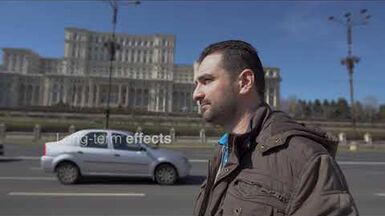Positive preliminary results of an Ebola vaccine efficacy trial in Guinea
The interim results were so convincing that the randomisation was stopped so that all participants could be offered the vaccine immediately. An Ebola vaccine will not eradicate the disease but it is likely to become a key tool for responding to future outbreaks.
The interim analysis of the results from a randomised phase III vaccine efficacy trial conducted in Guinea have shown that the VSV-EBOV vaccine is likely to be highly effective against Ebola.
The preliminary results, which were published today in The Lancet and presented by WHO, give reason to believe that this may be the first effective Ebola vaccine. None of the 2 014 contacts of Ebola patients who were vaccinated immediately after exposure developed disease more than 10 days after vaccination. Sixteen of the 2 380 persons in the contact group who were vaccinated three weeks after exposure, developed the disease.
An independent committee that monitors the study concluded that the interim results were so convincing that the study should continue and that randomisation should be stopped so that all participants could be offered the vaccine immediately.
Randomisation stopped on 26 July and the study will from now on also include contacts aged 13 to 17 year (and possibly 6 to 12-year-old children) on the basis of new evidence from vaccine safety studies carried out in Gabon. The same vaccine is currently being trialled also among frontline healthcare workers in Guinea.
The vaccine trial was conducted in collaboration between health authorities in Guinea, the World Health Organization, Médecins Sans Frontières (MSF) and the Norwegian Institute of Public Health with support from a broad partnership of international and national organisations.
The randomised study design is based on ring vaccination, an approach used in the 1970s for the eradication of smallpox. To date, more than 4 000 close contacts of nearly 100 Ebola patients have participated in the trial after giving informed consent. As soon as a new Ebola case was laboratory confirmed, the close contacts of this person and their contacts were invited to be vaccinated in a “ring” around the patient. At random, half of the contacts were vaccinated immediately while the other half were vaccinated three weeks later. The number of new Ebola disease cases were then compared in the two groups. This strategy allows researchers to draw a comparison between the different rings (immediate and delayed vaccination) and avoid using a placebo (or inactive control) that would otherwise be administered to half of those taking part in the clinical trial.
The VSV-EBOV vaccine used in the trial is based on an animal virus called vesicular stomatitis virus (VSV) that is combined with a portion of the protein covering the Zaire Ebola virus. It does not contain live Ebola virus which means that there is no risk of the vaccine causing Ebola virus disease. The vaccine was developed by the Public Health Agency of Canada. The vaccine was licensed to NewLink Genetics but since November 2014, it is Merck & Co that has the responsibility to research, develop, manufacture, and distribute the investigational vaccine.
ECDC comment
The results from this vaccine trial are very promising and represent, if re-confirmed, a major breakthrough in the control of Ebola virus disease. Expansion of the ring vaccination trial to include all contacts of all newly detected Ebola disease virus cases in both Guinea and Sierra Leone will require rapid mobilisation of resources.
Recommendations on how the vaccine will be used are expected soon from the WHO expert committee on immunization (SAGE), while arrangements for vaccine programme delivery will be the responsibility of the health authorities of the country in which the vaccine is to be used. The vaccine exists in limited quantities and it is expected to take weeks, if not months, to scale-up the production. The vaccine still requires marketing authorisation by appropriate regulatory authorities.
The rational use of this vaccine is for vaccination of contacts and first line responders around a case of Ebola in order to break the chain of transmission and stop the outbreak. It is not expected that the vaccine will be available for travellers to Ebola risk areas or that it will it be used for mass vaccinations.
Healthcare workers have been particularly affected by the Ebola epidemic in West Africa and a decision on whether to vaccinate frontline healthcare workers as a pre-exposure preventive measure or to include healthcare workers in the post-exposure ring vaccination will need to be taken as early as possible.
Ring vaccination will only be effective when cases of Ebola virus disease are detected and confirmed in a timely manner, and if efforts to strengthen surveillance and contact tracing are maintained.
It appears that a single dose of the vaccine provides effective post-exposure prophylaxis, which is an advantageous property when the aim is to deploy reactive vaccination in order to control an outbreak.
It is not yet known how long the vaccine will be protective or whether booster doses will be needed. These are important questions if the aim is to provide pre-exposure prophylaxis to healthcare workers in Ebola endemic areas. An Ebola vaccine will not eradicate the disease since outbreaks are caused by zoonotic introductions but it is likely to become a key tool for responding to future outbreaks.
Related links
The Lancet
Read more




